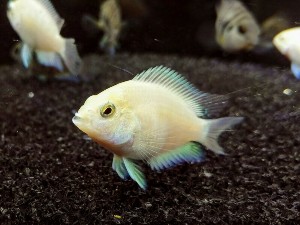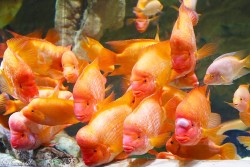Pink Convict Cichlid (Archocentrus nigrofasciatus) CareSheet

The Pink Convict Cichlid is a hybrid between the
Archocentrus nigrofasciatus Convict Cichlid and the Archocentrus nigrofasciatus Convict Cichlid. This fish is also known as the
Zebra Cichlid or Convict Cichlid because the female has an orange patch on her stomach. The male is bigger, more uniform, and has a steeper forehead and longer fins than the female. The male will develop a fatty bulge on the forehead as he gets older. They make a stunning addition to any aquarium, but their aggressive habits make them unsuitable for a communal tank.
A 30 gallon minimum tank with a gravel bottom, boulders, and lots of hiding spots among the rocks or inverted pots is required for the Pink Convict Cichlid. As a kind of cover, floating plants are advised. Pink Convict Cichlids should only be kept with other aggressive fish of the same size or bigger because of their aggressive temperament.
The Pink Convict Cichlid is a cave breeder that can survive in a variety of water conditions. Raise the water temperature to 75-79°F to encourage breeding. Between a cave and an open region, several females will spawn. The male and female of the Pink Convict Cichlid quickly couple and create a patriarch/matriarch family, with both caring for the young. Both the male and the female will send signals to the fry. Most prepared and frozen meals, including
freeze-dried bloodworms,
tubifex, and
ocean plankton, as well as
flake food and
Cichlid pellets, will be eaten by the Pink Convict Cichlid.
Requirements for keeping Archocentrus nigrofasciatus
Minimum Tank Size: 30 gallons
Care Level: Difficult
Tank Conditions: 75-79°F; pH 6.5-8.0
Max. Size In Aquarium: Up to 6"
Temperament: Aggressive
Diet: Omnivore

PINK CONVICT FISH TANK: Breeding Convict Fish!
Pink Convict species profile
Synonyms
Archocentrus nigrofasciatus is commonly known as the Convict cichlid and is also referred to by its former scientific name, Cichlasoma nigrofasciatum.
Common names
The common names for Archocentrus nigrofasciatus include Convict cichlid, Zebra cichlid, and Convict fish.
Etymology
The species name "nigrofasciatus" derives from Latin, where "niger" means black and "fasciatus" means banded. This refers to the distinct black bands that adorn the fish's body, contributing to its recognizable appearance.
Classification
Archocentrus nigrofasciatus belongs to the family Cichlidae and the genus Archocentrus. It falls under the order Perciformes.
Distribution
Archocentrus nigrofasciatus is native to Central America, specifically Honduras, Nicaragua, Costa Rica, and Panama. It has also been introduced to various other regions.
Habitat
This species inhabits various freshwater environments, including rivers, streams, and lakes, often preferring areas with rocky substrates and ample hiding spots among submerged vegetation.
Maximum Standard Length
The maximum standard length of Archocentrus nigrofasciatus is around 4 to 6 inches (10 to 15 cm).
Aquarium Size
A suitable aquarium for Convict cichlids should ideally be at least 30 gallons for a pair, with additional space for territorial behavior.
Maintenance
Maintaining Convict cichlids requires regular water changes, adequate filtration, and providing hiding spots using rocks or decorations.
Water Conditions
Convict cichlids thrive in water temperatures around 72-82°F (22-28°C) and prefer slightly alkaline to neutral pH levels (pH 6.5-8.0).
Diet
These cichlids are omnivorous, consuming a diet that includes high-quality pellets, flakes, and live or frozen foods like brine shrimp, bloodworms, and small insects.
Behaviour and Compatibility
Archocentrus nigrofasciatus are known for their aggressive and territorial behavior, often being best kept in species-only tanks or with robust tankmates that can hold their own.
Sexual Dimorphism
Sexual dimorphism is present, with males being larger and more brightly colored than females. Males also develop longer fin extensions.
Reproduction
Convict cichlids are prolific breeders and form monogamous pairs. They lay their eggs on flat surfaces and both parents participate in guarding and caring for the eggs and fry.
Endangered List
Archocentrus nigrofasciatus is not listed as endangered.
 The Pink Convict Cichlid is a hybrid between the Archocentrus nigrofasciatus Convict Cichlid and the Archocentrus nigrofasciatus Convict Cichlid. This fish is also known as the Zebra Cichlid or Convict Cichlid because the female has an orange patch on her stomach. The male is bigger, more uniform, and has a steeper forehead and longer fins than the female. The male will develop a fatty bulge on the forehead as he gets older. They make a stunning addition to any aquarium, but their aggressive habits make them unsuitable for a communal tank.
The Pink Convict Cichlid is a hybrid between the Archocentrus nigrofasciatus Convict Cichlid and the Archocentrus nigrofasciatus Convict Cichlid. This fish is also known as the Zebra Cichlid or Convict Cichlid because the female has an orange patch on her stomach. The male is bigger, more uniform, and has a steeper forehead and longer fins than the female. The male will develop a fatty bulge on the forehead as he gets older. They make a stunning addition to any aquarium, but their aggressive habits make them unsuitable for a communal tank.



